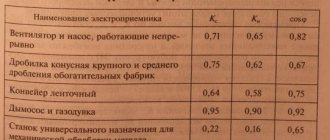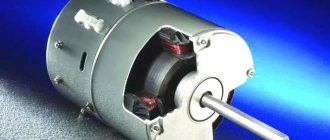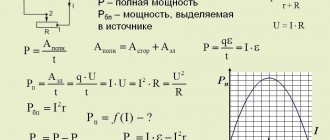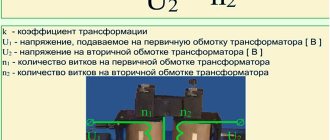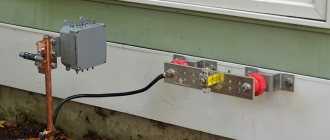Electrical equipment does not operate at full capacity all the time. This obvious fact can be understood using an everyday example. The lighting in the apartment is not turned on 24 hours a day. We use the iron only when we need to iron clothes. The kettle only works when you need to boil water. The situation is similar when it comes to electricity consumption in public and industrial buildings. Thus, the concept of installed and consumed (calculated) power is familiar to everyone since childhood. When designing the power supply of facilities, the non-simultaneous operation of equipment is taken into account using reduction factors. There are three reduction factors with different names, but their meaning is the same - demand factor, non-simultaneity factor, utilization factor. By multiplying the installed power of the equipment by one of these coefficients, the calculated power and the calculated current are obtained. Based on the design current, protective switching equipment (automatic circuit breakers, circuit breakers, RCDs, etc.) and cables or busbars are selected.
Pcalc = K×Pust, where Pust is the installed capacity of the equipment, Pcalc is the estimated power of the equipment, K is the demand/simultaneity/use coefficient.
When using this seemingly simple formula in practice, one is faced with a huge number of nuances. One of these nuances is the determination of the demand coefficient in panels that supply different types of loads (lighting, sockets, technological, ventilation and plumbing equipment).
The fact is that the demand coefficient depends on several parameters:
- Power;
- Load type;
- Type of building;
- Unit power of the electrical receiver.
Accordingly, when designing group and distribution networks, as well as electrical panel diagrams, this must be taken into account. Group networks (cables supplying end consumers) should be selected without taking into account the demand coefficient (the demand coefficient must be equal to one). Distribution networks (cables between switchboards) should be selected taking into account the demand factor. Thus, calculating the demand coefficient for switchboards with mixed loads brings additional difficulties and increases the complexity of the calculations.
Let's look at how the calculation of electrical loads is implemented in DDECAD using the example of a switchboard with a mixed load.
Initial data for calculation
As initial data, we assume that we need to calculate the loads for the office panel:
- The office has 6 rooms;
- Lighting using lamps with fluorescent lamps;
- The socket network for computers and “household” consumers is made separately;
- The office has air conditioning;
- The office has a dining room with a kettle, microwave, refrigerator and TV.
We distribute consumers into groups and fill out the calculation table.
Determination of the coefficient
Many novice electricians suffer greatly from the fact that they cannot understand for themselves what exactly the demand coefficient of electrical equipment is; the table does not make any sense to them, since it simply indicates devices and some numbers. So what is this coefficient? To begin with, you just need to familiarize yourself with its definition - it, of course, may not immediately seem clear to you, but as you read this material you will understand more and more. So, the demand coefficient of electrical equipment (the table for it will be considered separately, now only theory is taken into account) is the ratio of the combined maximum load of energy receivers to their total installed power. The definition is quite capacious, however, as was said earlier, it is not immediately possible to understand what its essence is - it’s just extremely difficult to understand from one sentence how the demand coefficient of electrical equipment is used. The table will not help you understand the issue, so you should postpone its consideration until a later time. Now you just need to try to understand the essence of this concept.
Calculation of shield demand coefficient
The calculation of the demand coefficient for the shield will be carried out in two stages:
- Determination of demand coefficients for different types of consumers;
- Determination of the demand coefficient for the shield.
However, technically, this requires three steps in the DDECAD calculation table:
- Determination of demand coefficients for different types of consumers;
- Determination of the demand coefficient for the shield;
- Indication of demand coefficients for the shield and for groups.
2.1. Calculation of lighting network demand coefficient
Calculation of the demand coefficient for calculating the supply, distribution network and inputs into buildings for working lighting are carried out in accordance with the requirements of clause 6.13 of SP 31‑110‑2003 according to Table 6.5.
The demand coefficient for calculating the group network of working lighting, distribution and group networks of emergency lighting is taken equal to one in accordance with clause 6.14 of SP 31-110-2003.
Installed power of work lighting fixtures Rust osv. = 7.4 kW. We accept that the office in question belongs to buildings of type 3 according to Table 6.5 SP 31-110-2003. This capacity is not included in the table, therefore, in accordance with the note to the table, we determine the demand coefficient using interpolation. DDECAD users can easily and quickly determine the demand factor using the program's built-in calculation. We get Ks osv. = 0.976.
2.2. Calculation of the demand coefficient of the outlet network
The calculation of the demand coefficient of the outlet network is carried out in accordance with clause 6.16 of SP 31-110-2003 and Table 6.6. We get Ks roses. = 0.2.
2.3. Calculation of the demand coefficient of the computer power supply network
The demand coefficient for the computer power supply network is carried out in accordance with clause 6.19 of SP 31-110-2003 and Table 6.7. According to clause 9 of Table 6.7, for the number of computers more than 5, we obtain Ks com. = 0.4.
2.4. Calculation of the demand coefficient of the power supply network of multiplying equipment
The demand coefficient for the power supply network of the multiplying equipment is carried out in accordance with clause 6.19 of SP 31-110-2003 and Table 6.7. According to clause 12 of Table 6.7, for the number of copiers less than 3, we obtain Kc multiply. = 0.4.
2.5. Calculation of demand coefficient for technological equipment
The demand coefficient for the power supply network of kitchen equipment is carried out in accordance with clause 6.19 of SP 31-110-2003 and Table 6.7. Let us assume, in the general case, that kitchen equipment is technological equipment in the catering department of a public building. According to clause 1 of Table 6.7, the demand coefficient should be taken according to Table 6.8 and clause 6.21 of SP 31-110-2003. We get Ks kuh. = 0.8.
If the technological equipment for food preparation is not equipment in the catering unit of a public building, but is located in the eating area of a small office, then the demand coefficient should be taken as for an outlet network in accordance.
2.6. Calculation of demand factor for air conditioning equipment
The demand coefficient for the power supply network of air conditioning equipment is carried out in accordance with clause 6.19 of SP 31-110-2003 and Table 6.7. According to item 5 of Table 6.7, the demand coefficient should be taken according to item 1 of Table 6.9 SP 31-110-2003. We get Kc cond. = 0.78.
2.7. Calculation of shield demand coefficient
The calculation of the shield demand coefficient will occur in two stages.
2.7.1. Determination of the demand coefficient for the shield
We enter the selected demand coefficients for each type of load in the “Coefficient” column. demand", column "D" in Excel. It turns out that we are setting demand coefficients for the group network. This is incorrect, but this is an intermediate step, we will correct this in the next step.
2.7.1. Indication of the demand coefficient for the shield and for groups
After entering the coefficients in the previous step in the bottom line, we get the calculated final coefficient of demand for the shield in the column “Coefficient. demand", column "D" in Excel.
The next step is to enter this value into the cell of the column “Kc per shield”, column “N” in Excel. After this, we return the group demand coefficients to their original value equal to one.
Installed capacity utilization factor
Introduction to the oil circuit breaker
One of the most important indicators of the operational efficiency of any enterprise associated with the supply, distribution and generation of electricity is the installed capacity utilization factor. Its value is equal to the arithmetic mean power divided by the installed power measured in a certain period of time. The importance of this indicator is aimed at the overall efficiency of electrical substations. Here it is important not only their technological improvement and equipping with modern equipment, but also the qualifications of the personnel managing electrical installations.
When designing and calculating loads on the power supply network, entire design departments work and they already use not only the demand coefficient, but hundreds of other indicators that must correspond to the PUE. So you can’t do without this reference book and its recommendations regarding various aspects.
Result
As a result, we obtain a correctly calculated demand coefficient for the shield and the correct calculated powers and currents in the group network.
Next, DDECAD users continue to fill out the calculation table, which automatically calculates short-circuit currents, voltage losses (drops), and RCD leakage currents. After pressing one button, a single-line diagram of the shield is automatically obtained in AutoCAD.
Subscribe and receive notifications of new articles by e-mail
Electrical equipment demand coefficient table PUE
The demand coefficient of electrical equipment is the ratio of the calculated power (Рр) to the total rated power of a given group of electrical consumers.
Kc=Pr/Rn
Regulatory documents provide tables of demand coefficients depending on the number of consumer groups and their purpose. With a known rated power (Рн) of the group and a known number of such consumers, the calculated power can be easily calculated
Рр=Кс*Рн
It would seem nothing complicated, but, as practice shows, an error in such a calculation can then cost a lot for the enterprise and its power supply.
To understand the essence of this meaning, you need to understand that electrical equipment in production is not only light bulbs and motors, it is substations of enormous power, machine tools, heating furnaces, diesel generator systems (generator-engine), and ventilation systems. Of course, when making calculations, you need to know the power of each unit so that their total power has the required amount of current. This is the difference between the calculated power and its actual performance. The table does not list any specific electrical equipment, but only certain workshops of enterprises.
Here is a calculation table of the most common electrical receivers at a substation and the corresponding demand coefficient.
The calculated power is the basis when choosing protective and switching equipment, as well as when calculating the cross-section of conductive cables and busbars. The demand coefficient itself is just a tool for calculating and determining the amount of design power.
As for production capacities, let's look at some of them:
- Workshops for general industrial purposes. They do not include construction equipment, as well as equipment used in highly specialized workshops. And the demand factor ranges from 0.35 to 0.8. In this case, the first values apply to auxiliary and additional workshops, higher indicators are in departments where there is heat treatment.
- Copper smelting plants. In the table of the book PUE (electrical installation rules) this is a plant specializing only in the remelting of copper products and the production of copper. The equipment here is similar to the previous facilities, except, of course, for water jackets and reflective stoves. Their coefficient is about 0.5.
- Metallurgical plants of non-ferrous metals. Here, types of equipment such as drying drums and special laboratories are very often used, with a coefficient of 0.25. There are also workshops here that are more demanding in terms of loads, for example, the electrolysis department with a coefficient of 0.7.
Demand Coefficient Method
The basic calculation formula is: Рр= Кс•Руст ; Qр = Рр×tgφ,
To find the design load of a group of consumers homogeneous in operating mode, use the following expression:
Pp = Kс ×Рн;
Qp = Рp×tgj,
where Kс and tgj are the demand coefficient of the receiver group.
To find the design load of one of the sections of the object or the object itself as a whole, it is necessary to add up the coefficients of different times of load maximums and the design loads of individual groups of receivers.
Calculation using the demand coefficient method has its disadvantages. The main thing is that for all consumers the value of the demand coefficient is assumed to be the same. However, it is assumed to be the same for the optimal number of subscribers.
The demand method is usually used in situations where there is no specific data about the subscriber.
Power load calculation:
Pp = Pmax = Kc* Pset = 0.3 * 16130 = 4839 kW
Qp = tgф * Pp = 0.88 * 4839 = 4258.3 kvar
In addition, it is necessary to take into account the load of artificial lighting in workshops and the plant area.
Below you can use the online calculator to calculate the cost of designing power supply networks:

